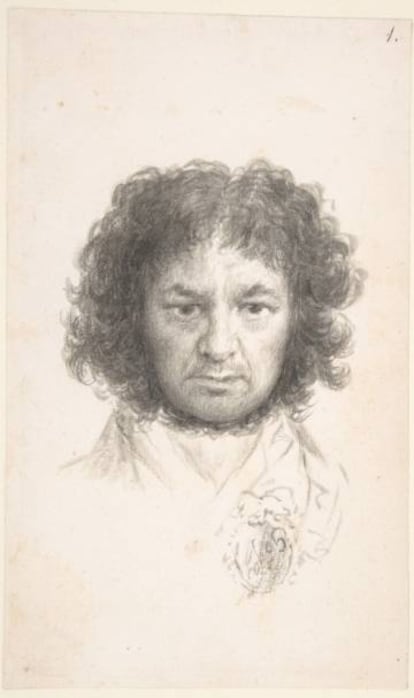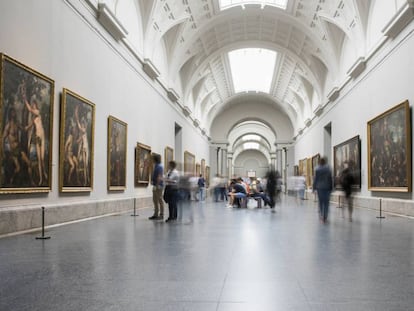Goya blows out the candles on the Prado Museum¡¯s 200th birthday
The most ambitious display of drawings by the master to date brings the celebratory series of exhibitions to a close
Madrid¡¯s famous Prado Museum celebrated its 200th anniversary last week. The Royal Museum of Paintings and Sculptures, as the Prado was first known, opened its doors on November 19, 1819. Two hundred years have passed since then, but at least one thing has not changed: Spanish artist Francisco Goya.
Goya, who was born in 1746 and died in 1828, was Spain¡¯s most important contemporary artist back in his day, and arguably still is. There are few issues of current concern, including gender violence, populism, inequality and the hypocrisy of the ruling elite, that were not addressed by the master.
This is particularly evident in his drawings, which are the focus of a new exhibition at the Prado entitled ¡°Solo la Voluntad Me Sobra¡± (or, Only My Strength of Will Remains). With 300 drawings on display, it is the biggest collection of his work on paper to date.
There is no current artist who has known how to express our nightmares with such precision
Miguel Falomir, director of the Prado Museum
The aim of the exhibition is to highlight the relevance of his legacy. ¡°I often get asked whether exhibiting contemporary art in these galleries would be appropriate,¡± says Miguel Falomir, the director of the Prado Museum. ¡°But I believe nothing could be more contemporary than Goya¡¯s work on paper. There is no current artist who has known how to express our nightmares with such precision and depth.¡±
The importance of Goya in the context of the museum, and his relevance to our current era convinced those in charge that the anniversary celebrations ¨C that started in November 2018 with a parade through the museum¡¯s collections ¨C should end with the artist. After all, his 133 paintings, 500 drawings and valuable documents such as his correspondence with his close friend Mart¨ªn Zapater, have made him one of the main pillars of the museum.

But can Goya still surprise us? According to the exhibition¡¯s curators, Manuela Mena and Jos¨¦ Manuel Matilla, these little-known etchings still have the power to do so.
The museum owns the most complete collection of Goya¡¯s drawings in the world, but they cannot be on permanent display due to their conservation requirements. This means they are only shown on special occasions, such as the 2015 exhibition of 80 Goya drawings at the Santander Bot¨ªn Foundation ¨C one of the entities collaborating in the current exhibition.
Indeed it was at this exhibition that Matilla had a ¡°revelation.¡± Conventions dictate that the drawings, because of their small size and the attention they require, should be displayed on a dark background. But Matilla, the head of the Prado¡¯s conservation of drawings and prints, decided to turn that on its head. Those who see the Goya exhibit in the Prado are surprised by the lack of color on the walls. This strategy gives the space the white cube look of a modern art gallery, and means that lightning that is less damaging to the paper can be used.
The bold arrangement of the works, designed by Juan Alberto Garc¨ªa de Cubas, adds to this modern feel. The etchings are displayed in 23 blocks around two structures in the shape of a cross, which expand the exhibition space. The drawings are well-numbered to allow the visitor to follow the thread chronologically and thematically.
¡®Italian Sketchbook¡¯
Visitors to the exhibition will be able to take a look at Goya¡¯s famous Italian Sketchbook, the first bought by the artist to sketch his ideas on his first stay in Rome, where he would sit by fountains to perfect his sketching technique. Next in the exhibition are Goya¡¯s Pilar Basilica frescoes in Zaragoza, followed by his commercial etchings inspired by Spanish painter Diego Vel¨¢zquez, letters complete with doodles, more sketchbooks from places such as Sanl¨²car de Barrameda, Madrid and Burdeos, lesser-known series such as The Magic Mirror, and the creative seeds of his famous print collections in which his dreams mix with nightmares and criticism with irony, namely Los Caprichos, La Tauramaqui (or, Bullfighting), Los Disparates (or, The Follies) and Los Desastres de la Guerra (or, The Disasters of War). The exhibition ends with work depicting issues that were important to the artist: violence against women, bullfighting, old age, and the manipulation of the masses by the elite.

Some of the drawings are mounted on pedestals; in the case of the?Sue?o de Bruja Principianta (or, Dream of a Beginner Witch, 1797), this allows the visitor to get an insight into what was going on in the mind of the artist, who drew on both sides of the page. In a different room, work from one of the three albums that were artificially put together from the sketchbooks by Goya¡¯s son Javier after the artist¡¯s death, have been taken from the album and displayed on the wall. This album was sold in 1866 by Goya¡¯s grandson Mariano to the Trinidad Museum, whose collection merged with the Prado¡¯s six years later.
The arrival of these works was key for the Prado and its relationship with Goya, whose association with the museum came early on, though it¡¯s impossible to say if it was early enough for him to be present at its inauguration. Curator Manuela Mena likes to think that perhaps Goya left his house for the grand event that day, which she describes as ¡°a very cold day in Madrid,¡± and then later fell sick with the illness that would take him a month to recover from. Matilla went further: ¡°Perhaps he was annoyed to see himself hanging in the contemporary galleries and not with [Diego] Vel¨¢zquez.¡±
Six years after the museum opened its doors, Goya wrote from Burdeos to Joaqu¨ªn Mar¨ªa Ferrer, a Spanish politician and book editor who was exiled in Paris. ¡°Thank me for this bad handwriting,¡± he said. ¡°Because [I have] neither sight, nor pulse, not pen, nor inkwell, I lack everything and only my strength of will remains.¡± The last phrase was the inspiration for the title of the exhibition.
The passion for collecting work by Goya has been a constant throughout the Prado¡¯s 200-year existence. As recently as 2018, it acquired a 1790 letter to Mart¨ªn Zapater, containing two drawings, which is part of the current exhibition.
The exhibition is on display at the Prado Museum until February, 16, 2020.
English version by Heather Galloway.
Tu suscripci¨®n se est¨¢ usando en otro dispositivo
?Quieres a?adir otro usuario a tu suscripci¨®n?
Si contin¨²as leyendo en este dispositivo, no se podr¨¢ leer en el otro.
FlechaTu suscripci¨®n se est¨¢ usando en otro dispositivo y solo puedes acceder a EL PA?S desde un dispositivo a la vez.
Si quieres compartir tu cuenta, cambia tu suscripci¨®n a la modalidad Premium, as¨ª podr¨¢s a?adir otro usuario. Cada uno acceder¨¢ con su propia cuenta de email, lo que os permitir¨¢ personalizar vuestra experiencia en EL PA?S.
?Tienes una suscripci¨®n de empresa? Accede aqu¨ª para contratar m¨¢s cuentas.
En el caso de no saber qui¨¦n est¨¢ usando tu cuenta, te recomendamos cambiar tu contrase?a aqu¨ª.
Si decides continuar compartiendo tu cuenta, este mensaje se mostrar¨¢ en tu dispositivo y en el de la otra persona que est¨¢ usando tu cuenta de forma indefinida, afectando a tu experiencia de lectura. Puedes consultar aqu¨ª los t¨¦rminos y condiciones de la suscripci¨®n digital.












































